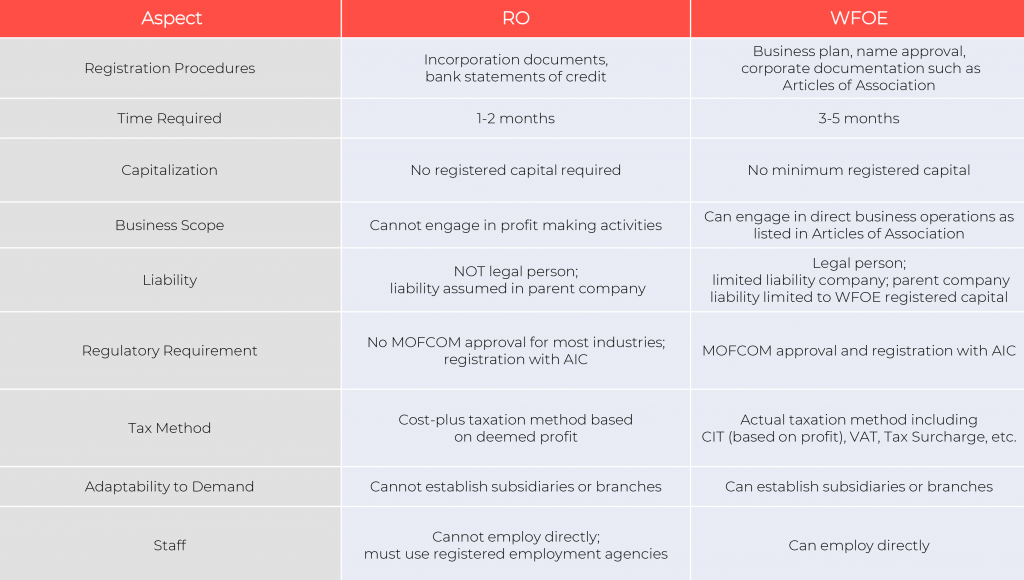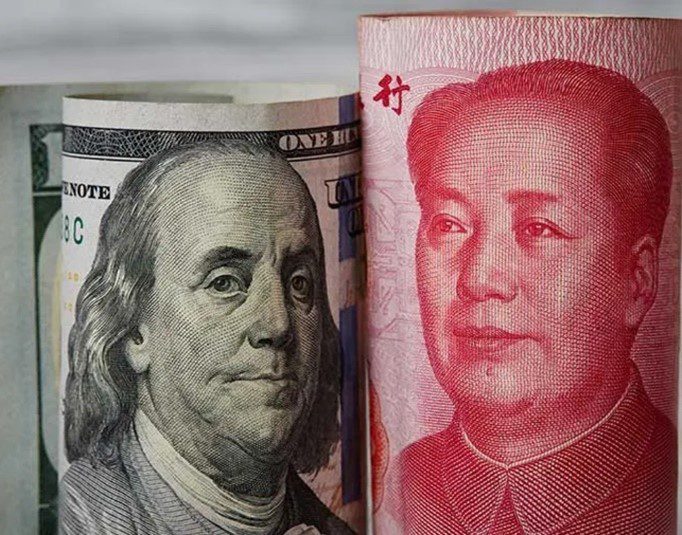Foreign-invested enterprises in China usually come in three different forms including Wholly-Foreign-Owned Enterprises (WFOE), Representative Office (RP), and Joint Venture (JV). The latter is the most difficult to open since as the structure name suggests, it requires a partnership with a Chinese entity. Thus, it is more complex considering the issues of finding a suitable partner and aligning business decisions.
Check out our article on Joint Ventures in China: How to Make your Partnership Successful?
Entering the Chinese market requires interested parties to plan the type of business structure they want to invest in. Hence, if you are thinking about opening your business in China, establishing WFOE or RO is the way to go. Keep reading to learn more.
The difference between RO and WFOE
The legal status and source of funds are two of the major differences between RO and WFOE. RO has no limited liability as it is only an extension of a foreign parent company. Moreover, its source of funds is exclusively coming from the head office. Thus, the head office is liable for all RO activities in China. On the other hand, WFOE is a limited liability company which means that it is a whole legal entity in China. This type of business requires a foreign capital requirement based on the business scope prescribed by the Chinese government.
However, in a practical sense, foreign entities may tend to abuse the readiness of RO establishment due to its more lenient requirement. Thus, the Chinese authorities have recently amended the rules regarding RO. It is now required for parent companies to have been established for a minimum of 2 years before it can register a representative office in China. Moreover, ROs are subject to scrutiny and procurement of accounting records.
Compare and contrast: A quick review

Cost-plus taxation formula for CIT
CIT = Deemed revenue x profit rate deemed by the tax bureau x 25%
*Deemed revenue = Cost or expenditure/ (100% – profit rate deemed by the tax revenue (for instance, 15%)
Tax and accounting method
RO and WFOE differ at large when it comes to financial accounting and taxation. While the former’s financial accounting is relatively simple, the latter involves a relatively complex procedure such as revenue recognition and overall cost accounting.
RO may only subject to corporate income tax (CIT) or value-added tax (VAT) while WFOE pays for CIT as well as VAT and other taxes. This is due to its commercial nature where it generates an actual business income.
To see more details of taxation for WFOE, have a look at An Investor’s Guide to Incorporating WFOEs in China
In practice, ROs in Beijing and Guangdong do not need to pay VAT while ROs in Shanghai do.
Advantages of WFOE over RO
Although RO is easier to register than WFOE, there are also some disadvantages that may outweigh its advantages in the long run. For example, ROs cannot engage in profit-making activities. It also only focuses on market research, promotion, and other liaison activities in connection with the parent company. Thus, the absence of revenue entails that ROs cannot receive payments, issue invoices (fapiao), or sign contracts. Furthermore, parent companies of ROs cannot have full control of all business processes, daily operations as well as protection of intellectual property (IP) rights.
Nevertheless, it is possible to switch from RO to WFOE type. But it is recommended that a WFOE registration process must take place first before closing a Representative Office.
Read our previous article on Representative Office in China: How to Set Up One?
How to switch from RO to WFOE?
Moving from RO to WFOE is driven by many reasons especially because as the RO expands, it becomes difficult to remain limited on what it can do. The tax liabilities of the RO may grow over time and the inability to issue a fapiao may become a problem. Furthermore, after conducting several market or promotion activities, the RO realizes the need to make a profit in China.
After registering the WFOE and getting a business license, the RO employees can now be transferred to the WFOE with new contract agreements. Before that, however, the RO must negotiate with the hiring agency regarding the terms and conditions of termination. Finally, the closing or de-registration of the RO shall take place for 4 to 6 months depending on the circumstances.
Key takeaways
It is essential for businesses under RO to understand the full extent of WFOE management before making any decisions to switch. More often, ROs are established when venturing through the Chinese market and building a local network. This means that the switch to WFOE must be considered only when there is a 100 percent viability to do business in the long term. With that said, investing in WFOE requires confidence and experience in the Chinese market.
Contact us
If you want further assistance regarding the procedures and tax concerns of establishing a WFOE or RO in China, you may contact us or call our offices in different China locations. Also, visit our tax and accountancy page to see more details of our specialist services.
Moreover, you can take advantage of our easy-to-use, 24-hour access management tool like Kwikdroid. Kwikdroid is a Cloud-based accounting and company solution that will be made available in your workplace in no time.

S.J. Grand also offers Cloud ERP services for your business if you are currently experiencing difficulty in managing your operations amid the COVID-19 pandemic. Check out our IT services page for more details.If you want to know more about doing business in China, contact our team for consultation and assistance. Follow us on social media to get the latest news!
Our experienced team has the necessary expertise and the know-how to support you with your business – have a look at the services we offer.







